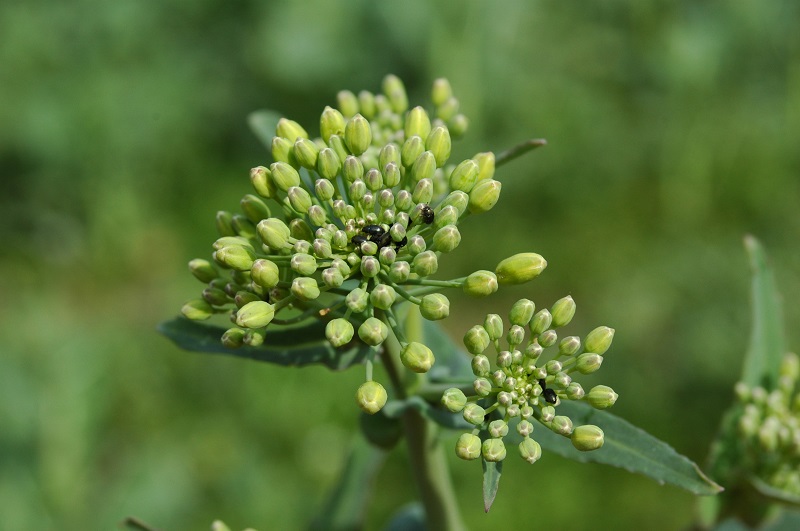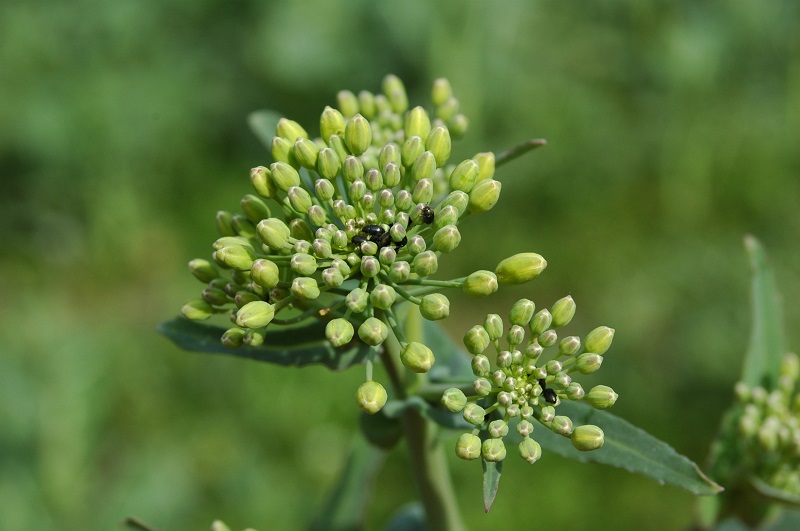Download article

 Few things can be more galling to an arable farmer than to inspect a crop and find it’s being eaten alive. Whether it’s cabbage stem flea beetle (CSFB), pollen beetle, pigeons or slugs, the instant reaction is to harness whatever means necessary to quell the intrusive foe.
Few things can be more galling to an arable farmer than to inspect a crop and find it’s being eaten alive. Whether it’s cabbage stem flea beetle (CSFB), pollen beetle, pigeons or slugs, the instant reaction is to harness whatever means necessary to quell the intrusive foe.
Recent research, however, suggests an oilseed rape crop, at least, may not be that bothered by the hungry hoards that may be devouring it. Rather than reach for the chemical can, the wisest course of action may be to sit on your hands and let nature run its course.
No impact on yield
“Growers shouldn’t be too quick to spray,” says Caroline Nicholls of AHDB Cereals and Oilseeds. “We know that in most years, pollen beetle populations rarely reach levels that are damaging to OSR. We’ve now shown through research that a plant can lose a surprising number of buds with no impact on yield.”
The research (see panel on below) has been carried out to validate the threshold levels for the pest that were changed recently (see box below). Questions had been raised as to whether the new threshold levels still held where the crop has suffered damage.
“It’s now part of the Sustainable Use Directive that growers should have an Integrated Pest Management (IPM) approach,” points out Caroline Nicholls. “Growers should always assessthe need to spray and threshold levels are there to help. With fewer active ingredients available and resistance increasing, it’s more critical than ever that insecticide use is minimised.”
The levels themselves are regularly reviewed, and this will continue, she assures. “The Pollen Beetle Predictor, developed through AHDB-funded research and accessed through the Bayer website, is another useful, validated tool. It uses a traffic-light system to forecast pollen beetle migration, so gives growers an idea of when to inspect the crop.”
When it comes to CSFB, AHDB recognises further work is needed on thresholds. “Guidelines are provided through Information Sheet 43, and there’s on-going research to improve understanding of the impact and nature of this pest in the absence of neonicotinoid seed treatments,” she reports.
Behaviour of larvae
Recent research has focused on the behaviour of larvae, and their impact on the crop. “An adult attack is very visible, but until recently, we’ve known little about the relationship with larval populations and the damage they do to yield.”
Dr Steve Ellis of ADAS has been leading recent work on pollen beetle. “The thresholds already take into account the fact an OSR plant produces more buds than it needs,” he points out.
“But there were still questions – for instance what happens if pollen beetles concentrate their attack on the main raceme? Also, what if the crop is damaged by pigeons?”

The thresholds take into account the fact an OSR plant produces more buds than it needs, says Steve Ellis.
Pest damage is being simulated in trial plots at ADAS High Mowthorpe and Rosemaund, which have been sown at both a high and low seed rates. Either 50% or all of the buds have been removed from the main raceme in 1m² quadrants of trial plots during the green/yellow bud stage. “Typically 74 buds have been removed, which would be the equivalent of a significant infestation of pollen beetles.”
Pigeon damage was replicated by mowing plots before the start of spring growth. The replicated plots were then taken to yield to assess the effect and any interaction between simulated damage by pigeons and pollen beetles. “So if a crop was damaged by pigeons, we wanted to know whether subsequent pollen beetle damage would have more impact on yield.”
In the first year (2014 crop), defoliation resulted in a 0.5t/ha yield loss, reports Steve Ellis. “But we did mow the crop quite late – not until Feb/early March. However there was no impact on yield from the pruning, and no interaction between pruning and defoliation..”
The following year, defoliation took place in Dec and Jan, and there was no statistical effect on yield, nor was there any yield loss from pruning. “At our open day in June, you couldn’t tell the difference between the plots, and this was confirmed at harvest,” he says.
Subsequent AHDB-funded research has also simulated of adult CSFB damage. “The simple truth is that OSR is an incredibly robust crop – you can do almost anything to it and it will compensate with phenomenal growth,” notes Steve Ellis.
Insecticide treatments
Running concurrently, trials at ADAS High Mowthorpe and Terrington have been assessing the effectiveness of various insecticide treatments on pollen beetle in OSR. “Yield wasn’t significantly affected by the treatment in any of the experiments, which doesn’t come as a surprise as we had a low number of pollen beetles recorded before treatment.”
He believes the pest rarely reaches a level in the crop at which there may be an impact on yield. “We may have reached a stage where we reconsider use of insecticide quite significantly.
“Growers have far fewer active ingredients than they did a decade ago, and pyrethroids are now the insecticides used in 90% of cases. With resistance increasing in CSFB, pollen beetle and aphids, there’s a cost of applying the chemistry that far outweighs the financial cost, and with pollen beetle at least, there’s questionable benefit.”
So what about CSFB? For the past two years, AHDB Cereals and Oilseeds has funded work coordinated by ADAS to assess the incidence of the pest and the level of damage. In autumn 2015, a network of 56 AICC agronomists fed back reports on crop damage at two growth stages – cotyledon to leaf two, and the three to four-leaf stage.
“CSFB damage was present on 65% of crops at assessment one and 69% of crops at assessment two. But at assessment one, just 8% of crops had levels of damage in excess of 50% leaf area lost, while by assessment two, this had reduced to 4%,” notes the report.
Damage was more widely dispersed than in 2014, with the highest levels reported in Leics, Northants, Essex, Beds, Cambs and Yorks. Total crop loss was recorded in 0.8% of cases at assessment one, equivalent to 5000ha. By the second assessment, a “hotspot” of severe damage had also appeared in Bucks, and total crop losses had risen to 1%.
A further project has focused on the crop that survived in 2014 to get a better understanding of CSFB larval populations and impact. The adult beetle lays eggs in the soil in early autumn, which hatch out from Nov and all the through the winter, depending on conditions. As soon as the larvae emerge, they find the nearest OSR plant and burrow into the leaf petioles, usually moving into the main stem at some point in the early spring before pupation starts.
“A mild winter results in a longer period of egg-laying and egg-hatch,” notes Dr Sacha White of ADAS, who led the research. “We think the biggest impact on yield is when they start feeding on the stem, so wanted to monitor that.
“We also wanted to relate yield loss to larval pressure – there’s a treatment threshold of five larvae per plant, but that’s based on work carried out over a quarter of a century ago. So do modern varieties now differ in how they cope with infestation?”
Randomly sampled
In each high-incidence county (which for 2014 were Cambs, Herts, Hants, Suffolk, Surrey and Beds) a low risk and high risk field were monitored. Agronomists randomly sampled 25 plants and sent them to ADAS for analysis.
“We found very high larval numbers, above the treatment threshold, on half the sites monitored. Unsurprisingly, there was a high larval pressure at sites that had seen high adult beetle damage,” reports Sacha White.
But the low risk sites threw up an interesting result the researchers didn’t anticipate. “Some of them also had larval populations significantly above the treatment threshold. That’s important because it suggests larval infestation could be high even where adult damage was not seen as significant,” he points out.
Yield achieved across the sites was compared with the farms’ average OSR yield. “These weren’t replicated trials, but gave us an idea of impact,” he notes.
“But the relationship is unclear. There was a definite reduction in yield where there were very high numbers – one site that had 28 larvae/plant suffered a loss of 1.7t/ha, for example. But where there were 5-10 larvae/plant, the loss varied, and one site actually saw a yield increase.”
Assessments of where the larvae were in the plant threw up further surprises. “In mid Feb, 95% of larvae were still in the petioles. So we carried out a further assessment in April, and only 35% were found in the stems. We had expected to find more in the stems as they usually move here before dropping to the soil to pupate – they may have pupated before the April assessment but more work’s needed to deduce how they’re behaving.”
More research is also needed on yield impact, he says, although he believes the current threshold is likely to be too low. “We think an OSR plant can withstand an infestation above the current threshold with little impact on yield,” notes Sacha White.
“But one thing that stood out from the research was how localised infestations were and the incredibly high larval populations we found – one plant in Cambs had 57 larvae for example, and that crop averaged 28 larvae/plant. OSR is a resilient crop, but it’s clear there are situations where CSFB are putting it under severe pressure.”

Risk too great in CSFB hotspots
Andrew Blazey openly admits that CSFB is a pest he’s quick to spray against. An agronomist with Prime Agriculture, he has clients in Essex, South Suffolk and East Cambs, and he’s seen too many cases of complete crop loss as a result of the pest.
“I’d only ever advise treatment if threshold levels are exceeded and there’s clear evidence of active feeding and that the crop is under stress. But you can’t afford to let CSFB graze, especially at the cotyledon stage – one nip and the plant’s gone.”
When it comes to the larvae, they’re a very tricky beast to monitor, he says. “I’ve dissected plants and found larvae at the 1-2mm stage as well as 6mm within the same plant. You find them in the leaves, in the stem, and where it’s most worrying is where they travel up with the growing point – that’s where the plant comes under severe stress.
“The issue that concerns me is just how many crops I’m finding where the pest is above threshold levels – there are often more than 20 larvae/plant in high risk crops, but also 5-10 larvae/plant where significant grazing by adults hadn’t been identified.”
He hopes on-going research will give growers and agronomists a clearer idea of the pest’s behaviour and appropriate timings for treatment. “Treating CSFB larvae is very hit-and-miss, and once it’s in the stem it’s too late. We do need a clear understanding of resistance, however – no one’s quite sure to what extent the larvae can tolerate pyrethroids.”
Pollen beetle is a threat he’s more sanguine about. “It takes a while to get your head round the new thresholds – it seems odd that the threshold is higher if the plant population is lower. But it makes sense when you take into account how a crop branches – OSR is a very resilient and robust compensator.”
He hasn’t had to treat for two years, and even then, it’s only if the threshold is exceeded on very backward crops that he’d consider it was in danger of losing a significant amount of yield. “Of course, pollen beetle is also a valuable pollinator, once the crop comes into flower.”
So pollen beetle is less a concern, in Andrew Blazey’s view. “But with CSFB, I’ve seen spectacular crop failures where growers have put in place every cultural method at their disposal, and larvae infesting crops that were treated with neonicotinoids. There will be growers withdrawing from the crop in my area – it’s just too risky.”
Research round-up
AHDB project 214-0005, Validation of an integrated pest management (IPM) strategy for pollen beetle to minimise the development of insecticide resistance, runs from Aug 2013 to Nov 2016. Its aim is to investigate the impact of different numbers of pollen beetle on the yield of OSR, simulating pollen beetle feeding damage by pruning buds and pigeon grazing by using a defoliation treatment, to provide guidelines on how best to monitor pollen beetle numbers, calibrate pollen beetle traps and to validate the accuracy of an on-line decision tool for pollen beetle immigration. The project is led by ADAS with Rothamsted Research as academic partner. The total cost is £120,000, funded by AHDB Cereals and Oilseeds.
AHDB project 2140038118, Cabbage stem flea beetle live incidence and severity of damage monitoring, ran from Aug to Oct 2015. Its aim was to provide evidence on the level of CSFB damage on OSR crops that haven’t received a neonicotinoid seed treatment, providing a second year of data to add to that collected by ADAS in 2014. The project was led by ADAS and its total cost was £14,975, funded by AHDB Cereals and Oilseeds.
AHDB project 214-0025, Cabbage stem flea beetle larval survey, ran from Jan 2015 to Oct 2015. Its aim was to assess CSFB larval populations and yield impact in the counties worst affected by adult feeding. The project was led by ADAS and it total cost was £15,010, funded by AHDB Cereals and Oilseeds.
AHDB Information Sheet 18, Monitoring and control of pollen beetle in oilseed rape, published in 2013, can be downloaded at http://cereals.ahdb.org.uk/publications – search for IS18.
AHDB Information Sheet 43, Cabbage stem flea beetle, can also be downloaded – search for IS43.




